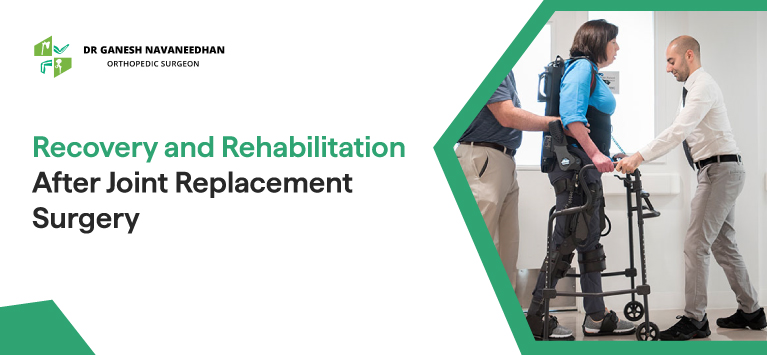- +91 62384 78716 +91 99475 78797
-
Sasthamangalam, Trivandrum
Sasthamangalam, Trivandrum
Table of Contents

We may even think life is never going to be the same after this major surgery.
Joint replacement surgery has become an effective solution for many people who are suffering from chronic joint pain. May it be hip, knee, or shoulder replacement, the procedure offers the promise of improved quality of life. The road to full recovery requires dedicated effort, proper guidance, and well structured rehabilitation plan.
But no more worries because we have you covered. You will come to know everything about recovery after Joint replacement Surgery in the below passage.
Table of Contents
Undergoing a Joint replacement surgery is a significant step toward regaining better mobility and reducing pain caused by joint deterioration. As you prepare for this transformative procedure, it’s important to have a clear understanding of what to expect after an arthroscopic surgery during the recovery phase.
Patients typically spend a few days in the hospital for monitoring and initial recovery right after the joint replacement surgery.
Pain management and wound care are critical during this phase for efficient after surgery care. It is accompanied with gentle exercises are initiated within 24 hours after the joint replacement surgery to improve blood circulation and prevent complications.
Home Care: Upon discharge, patients continue their recovery at home. It’s essential to have a support system in place to assist with daily activities.
Pain Management: Medications are prescribed to manage pain and inflammation. Following the prescribed regimen is crucial. Some may even think it may be difficult to live life after hip replacement, but that’s not the case because, after successful hip replacement surgery, one can typically regain mobility and is able to participate in daily activities with greater ease compared to their previous time.
Mobility Aids: Depending on the joint replaced, mobility aids like crutches, walkers, or canes might be used to ensure safe movement. Mobility aids are very essential for efficient knee replacement recovery at home
The Role of Family and Caregivers: The support of family members and caregivers plays a crucial role throught out the hip replacement recovery time or any other joint replacement recovery phase. Their assistance with daily activities, emotional encouragement, and overall presence can greatly contribute to your comfort and progress. Home is the best place to recover rather than any other hip replacement rehab because it creates a collaborative environment that accelerates your recovery process.
Significance of Medications: Effective pain management is a cornerstone of a speedy recovery after Joint replacement surgery. Pain medications prescribed by your Doctor not only alleviate discomfort but also facilitate your ability to participate in a smooth recovery process. Leading you to a quicker return to your daily activities like driving or weight lifting.
Managing Discomfort and Pain: Communication with your Doctor is the key. The Doctor will prescribe pain management medications tailored to your needs. Following the medication schedule will ensure consistent relief.
Regaining daily Mobility: Regularly performing prescribed range of motion exercises is vital. Gradually increase the intensity and duration of these activities under the guidance of your physical therapist.
Incorporating Healthy Habits: Prioritize proper nutrition, focusing on foods that aid in healing and tissue repair. Staying hydrated is equally important to support your body’s natural healing processes.
Recvery after a major joint replacement surgery may even take months, but by this time we may ask the question what to expect one year after total knee replacement or any Joint replacement surgery. The below table explain the process clearly.
| Time After Surgery | Rehabilitation Protocol |
| Day 1 – 2 | Initiate gentle range of motion exercises |
| Week 1 – 2 | Gradually increase range of motion exercises |
| Week 3 – 4 | Incorporate light resistance exercises for muscle activation |
| Week 5 – 6 | Intensify strengthening exercises |
| Week 7 – 8 | Focus on joint stability exercises |
| Week 9 – 10 | Transition to more functional exercises |
| Week 11 – 12 | Continue progressive strengthening exercises |
| Month 3 – 4 | Progress to moderate-intensity exercises |
| Month 5 – 6 | Gradually return to low-impact recreational activities |
| Month 7 onwards | Maintain an active lifestyle |
Please note that this table provides a general guideline for rehabilitation after joint replacement surgery and may vary based on individual patient needs and the specific joint replaced. Always follow your Doctor’s recommendations and consult with a physical therapist for a tailored rehabilitation protocol.
After six months, most patients experience significant improvement in Joints function. You’ll be able to engage in low-impact activities like swimming, cycling, and brisk walking. While you’ll continue to perform exercises to maintain joint health and strength, you’ll also have the freedom to enjoy a more active and fulfilling lifestyle.
Recovery and rehabilitation after joint replacement surgery demand commitment and perseverance. Following medical advice, adhering to the rehabilitation plan, and maintaining a positive outlook are very essential. We understood how rehabilitation and recovery after joint replacement surgery are very important, How to manage pain, We also got a complete idea of the full time line for recovery after the Joint replacement surgery. Each small step in the recovery journey brings you closer to restored mobility and an enhanced quality of life.
Remember, every individual’s recovery is unique. With the right care, support, and determination, you can achieve a successful recovery after a joint replacement surgery.
So, When are you going to take the first step towards a pain-free and active life?
Copyright © 2025 Dr. Ganesh Navaneedhan. All Rights Reserved. | Designed By Harvee healthcare